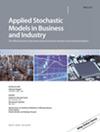Joint Tail Probability of Renewal Models of Dependent Heavy-Tailed Random Variables With Applications to Systemic Risk Measures
IF 1.5
4区 数学
Q3 MATHEMATICS, INTERDISCIPLINARY APPLICATIONS
引用次数: 0
Abstract
Consider a non-standard renewal risk model in which claims arrive in pairs and the stochastic discounting process is given by , where is a Lévy process. We are interested in the joint tail probability of and , the aggregate discounted claims along the respective lines . Assume that is a sequence of independent and identically distributed random pairs with generic pair . Further assume that follows a dependence structure encompassing both tail dependence and tail independence, and has regularly varying marginal tails. We derive asymptotic formulas for the joint tail probability of and . These results are then applied to evaluate two systemic risk measures. Finally, we conduct numerical studies to illustrate the theoretical findings.
相关重尾随机变量更新模型的联合尾概率及其在系统风险度量中的应用
我们导出了L 1 (t) $$ {L}_1(t) $$和L的联合尾概率的渐近公式2 (t) $$ {L}_2(t) $$。然后将这些结果应用于评估两种系统性风险措施。最后,我们进行了数值研究来说明理论结果。
本文章由计算机程序翻译,如有差异,请以英文原文为准。
求助全文
约1分钟内获得全文
求助全文
来源期刊
CiteScore
2.70
自引率
0.00%
发文量
67
审稿时长
>12 weeks
期刊介绍:
ASMBI - Applied Stochastic Models in Business and Industry (formerly Applied Stochastic Models and Data Analysis) was first published in 1985, publishing contributions in the interface between stochastic modelling, data analysis and their applications in business, finance, insurance, management and production. In 2007 ASMBI became the official journal of the International Society for Business and Industrial Statistics (www.isbis.org). The main objective is to publish papers, both technical and practical, presenting new results which solve real-life problems or have great potential in doing so. Mathematical rigour, innovative stochastic modelling and sound applications are the key ingredients of papers to be published, after a very selective review process.
The journal is very open to new ideas, like Data Science and Big Data stemming from problems in business and industry or uncertainty quantification in engineering, as well as more traditional ones, like reliability, quality control, design of experiments, managerial processes, supply chains and inventories, insurance, econometrics, financial modelling (provided the papers are related to real problems). The journal is interested also in papers addressing the effects of business and industrial decisions on the environment, healthcare, social life. State-of-the art computational methods are very welcome as well, when combined with sound applications and innovative models.

 求助内容:
求助内容: 应助结果提醒方式:
应助结果提醒方式:


